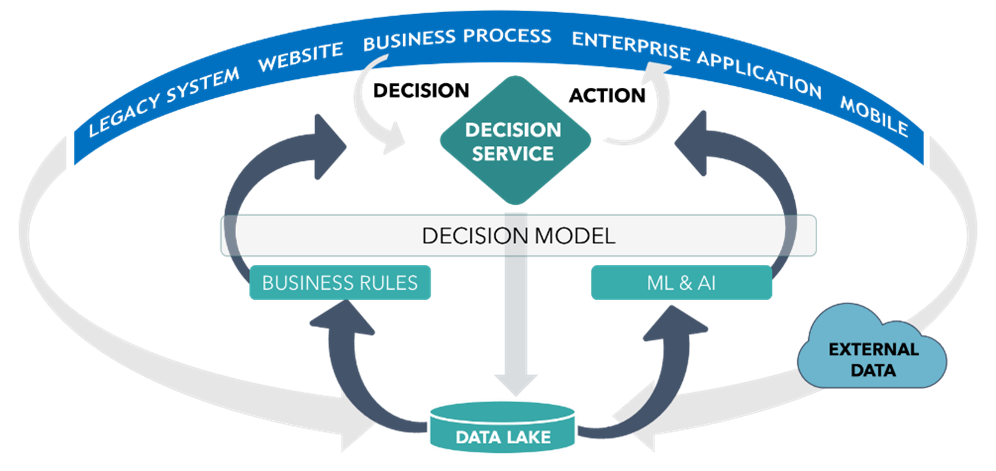
Make your transactions more profitable, more effective, and cheaper to handle by adding real-time decisions to your mainframe systems.
The heart of a real-time enterprise is the ability to make real-time decisions – to decide what offer to make, whether to pay a claim, or approve a loan request the moment the customer asks. There’s a great value proposition for real-time decisions and an established technology stack, including machine learning, business rules, AI, and decision automation platforms. But have you ever thought about pushing your real-time decisions to your mainframe? And, if not, why not?
The value proposition of real-time decisions
Why deliver real-time decisions? What’s the payoff for investing in real-time? Four things show up time and again – improved customer service, revenue growth through cross-sell and up-sell, risk management, and cost reduction.
Improved customer service
Your customers want immediate responses to often complex questions – questions where a good answer requires data analysis and the application of policies and regulations. If you can answer these questions and make these decisions in real-time, you can keep things moving without manual intervention or make them call the call center, and they will feel that you delivered better service.
Revenue growth
Real-time offers get accepted more readily. For instance, a real-time offer of a car loan is much more likely to be accepted than one made after a few hours. If you can decide that a prospect is a good risk and make them the offer immediately, you can almost double your acceptance rates – from 15 to 20% to 35 to 40%! This means more profitable revenue for you. More than that, it means you’re attracting the best customers in each risk tier, not the ones left when everyone else has had a try at them.
Better Managed Risk
Managing risk using predictive analytics and machine learning applied in real-time considers your risk transaction by transaction. Real-time risk decisions move you beyond after-the-fact portfolio analysis and put you on the front foot – acquiring the right risks at the right price.
Reduced costs
Finally, of course, real-time decisions lead to straight-through processing and hands-free transactions. This means less manual work and so less cost per transaction.
Ingredients of real-time decisions
Real-time decision services combine business rules, machine learning, and AI to implement a model of your decision making that matches your business needs.

Business Rules
The policies, regulations, guiderails, and constraints that make sure your decisions are legal and appropriate are managed using business rules management systems or decision platforms. This is critical to provide the flexibility and responsiveness you need for fast-changing decisions, as well as the transparency you need for regulators and auditors.
ML
Machine learning and other forms of advanced predictive analytics ensure that risk is managed, fraud is reduced, and opportunity is maximized as part of your decisions. This use of ML to optimize decisions about core operational transactions is central to how ML delivers value.
AI
Generative AI and LLMs can dramatically improve your customers’ interactions with your real-time decisions. While they can’t be trusted to MAKE business decisions, they can help determine which decisions are appropriate, make it easier for customers to provide the necessary data, and then explain the results in natural language.
Decision models
Making sure all these pieces fit together requires a visual blueprint, a decision model. Defined by your business experts and based on industry-standard notation, decision models bring everything together.
See also: Why the Mainframe is the Opposite of Legacy Tech
Why use the mainframe?
When organizations think about real-time decisions and applying these technologies, they often think about running everything in the cloud or on local containers. They rarely think about running this tech stack on their mainframe. Why should they? Well, real-time decision systems need all the standard capabilities mainframes deliver for transactional systems, like availability, reliability, and security. In addition, mainframes often have the first touch and most, if not all, of the data. Plus, they are high-performance and increasingly designed to accelerate this kind of processing.
First touch
Your mainframe is almost certainly the first system that handles a transaction. This means that if it also makes these real-time decisions, there’s no latency between transaction and decision. Any time you must wait for data to be moved off the mainframe before you use it, you introduce delay – you’re wasting time you could have used to respond to your customers.
Fresh Data
The data on your mainframe is fresh. It’s not stale because it hasn’t been copied somewhere else yet. It might seem easier to access the cleaned-up and migrated data, but it’s just stale. This fresh data can be used in a hybrid transactional-analytic processing (HTAP) model, too. With HTAP, your real-time decision can run its machine learning and AI models directly on “in-flight” transactional data as it is stored. No more “after the fact” analytics.
High Performance
Mainframes are high-performance beasts. Real-time decisions can get complex, with lots of rules and multiple ML models to be executed. Your mainframe has the power you need to make these decisions happen fast. Plus, your mainframe team is almost certainly already delivering on millisecond service-level agreements.
ML and AI accelerators
Modern mainframes have machine learning and AI acceleration built into their chips! Seriously, hardware acceleration for advanced ML is a thing these days. Scoring transactions in the cloud can take up to 100 milliseconds. With modern hardware acceleration, executing a scoring transaction on a mainframe can be accomplished within just a few milliseconds. As you enhance your real-time decisions with more ML and AI models, this advantage is only going to grow.
But whattabout…
Three complaints seem to crop up every time customers think about mainframes for real-time decisions – cost, service level agreements, and rigidity.
Cost
The biggest complaint about running real-time decisions on the mainframe is that mainframes are expensive. Well, yes, each mainframe is expensive to acquire, but this doesn’t mean mainframes are expensive on a “per transaction” basis. If you have a lot of transactions already and you know you must process them all, then the scalability of the cloud isn’t buying you much – but the cost effectiveness of a mainframe is.
Service level agreements
People don’t want to run anything on their mainframe that might slow core transaction processes. For instance, they don’t want to do analytic model training or reporting. This is why all the analytic work is moved off the mainframe, so it doesn’t slow the transactions. Well, that’s fine, but that doesn’t mean you can’t execute developed analytic and machine learning models on the mainframe – you can just build them somewhere else at your leisure. Executing these models won’t break your service level agreements, not with the power and accelerators of a modern mainframe.
Too rigid and hard to change
If your mainframe is rigid and hard to change, if you can’t readily deploy new business rules to it or update it regularly with new machine learning models, then your IT team just hasn’t got the memo yet! Many mainframe teams have integrated the same CI/CD pipelines, business rules management systems, MLOps, and agile best practices as their cloud colleagues. A rigid and hard-to-change mainframe is just a choice – and not a very smart one.
Don’t waste that first touch
Make that first customer touch the best it can be by pushing real-time decisions onto your mainframe. Your mainframe is a vital platform for handling your core transactions. Make those transactions more profitable, more effective, and cheaper to handle by adding real-time decisions to your mainframe systems.




























